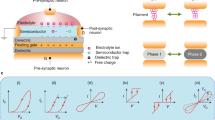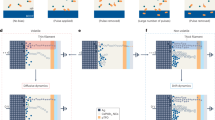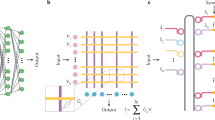Abstract
We are at an inflection point in computing where traditional technologies are incapable of keeping up with the demands of exploding data collection and artificial intelligence. This challenge demands a leap to a new platform as transformative as the digital silicon revolution. Over the past 30 years molecular materials for computing have generated great excitement but continually fallen short of performance and reliability requirements. However, recent reports indicate that those historical limitations may have been resolved. Here we assess the current state of computing with molecular-based materials, especially using transition metal complexes of redox active ligands, in the context of neuromorphic computing. We describe two complementary research paths necessary to determine whether molecular materials can be the basis of a new computing technology: continued exploration of the molecular electronic properties that enable computation and, equally important, the process development for on-chip integration of molecular materials.
This is a preview of subscription content, access via your institution
Access options
Access Nature and 54 other Nature Portfolio journals
Get Nature+, our best-value online-access subscription
$29.99 / 30 days
cancel any time
Subscribe to this journal
Receive 12 print issues and online access
$259.00 per year
only $21.58 per issue
Buy this article
- Purchase on Springer Link
- Instant access to full article PDF
Prices may be subject to local taxes which are calculated during checkout





Similar content being viewed by others
References
Rotman, D. Molecular computing. MIT Technology Review https://go.nature.com/3OSS3w1 (2000).
Cuevas, J. C. & Scheer, E. Molecular Electronics: An Introduction to Theory and Experiment (World Scientific, 2010).
Carroll, R. L. & Gorman, C. B. The genesis of molecular electronics. Angew. Chem. Int. Ed. 41, 4378–4400 (2002).
Chen, J., Reed, M., Rawlett, A. & Tour, J. Large on-off ratios and negative differential resistance in a molecular electronic device. Science 286, 1550–1552 (1999).
Hickmott, T. Low‐frequency negative resistance in thin anodic oxide films. J. Appl. Phys. 33, 2669–2682 (1962).
Chopra, K. Current-controlled negative resistance in thin niobium oxide films. Proc. IEEE 51, 941–942 (1963).
Dearnaley, G., Stoneham, A. & Morgan, D. Electrical phenomena in amorphous oxide films. Rep. Prog. Phys. 33, 1129 (1970).
Chua, L. Memristor—the missing circuit element. IEEE Trans. Circuit Theory 18, 507–519 (1971).
Strukov, D. B., Snider, G. S., Stewart, D. R. & Williams, R. S. The missing memristor found. Nature 453, 80–83 (2008).
Williams, R. S. Summary of the Faraday discussion on new memory paradigms: memristive phenomena and neuromorphic applications. Faraday Discuss. 213, 579–587 (2019).
Xiang, D., Wang, X., Jia, C., Lee, T. & Guo, X. Molecular-scale electronics: from concept to function. Chem. Rev. 116, 4318–4440 (2016).
Chen, H. & Fraser Stoddart, J. From molecular to supramolecular electronics. Nat. Rev. Mater. 6, 804–828 (2021).
Collier, C. et al. Electronically configurable molecular-based logic gates. Science 285, 391–394 (1999).
Geffroy, B., Le Roy, P. & Prat, C. Organic light‐emitting diode (OLED) technology: materials, devices and display technologies. Polym. Int. 55, 572–582 (2006).
Zou, S.-J. et al. Recent advances in organic light-emitting diodes: toward smart lighting and displays. Mater. Chem. Front. 4, 788–820 (2020).
Williams, R. S. What’s next?[The end of Moore’s law]. Comput. Sci. Eng. 19, 7–13 (2017).
Knight, W. AI can do great things—if it doesn’t burn the planet. Wired Magazine https://go.nature.com/3ORsdbG (2020).
Mehonic, A. & Kenyon, A. J. Brain-inspired computing needs a master plan. Nature 604, 255–260 (2022).
Jaeger, H., Noheda, B. & Van Der Wiel, W. G. Toward a formal theory for computing machines made out of whatever physics offers. Nat. Commun. 14, 4911 (2023).
Goswami, S., Goswami, S. & Venkatesan, T. An organic approach to low energy memory and brain inspired electronics. Appl. Phys. Rev. 7, 021303 (2020).
Valov, I. & Kozicki, M. Organic memristors come of age. Nat. Mater. 16, 1170–1172 (2017).
Gray, H. B. New structures in transition metal chemistry. Coord. Chem. Rev. 1, 156–163 (1966).
Jørgensen, C. K. Differences between the four halide ligands, and discussion remarks on trigonal-bipyramidal complexes, on oxidation states, and on diagonal elements of one-electron energy. Coord. Chem. Rev. 1, 164–178 (1966).
Goswami, S., Mukherjee, R. & Chakravorty, A. Chemistry of ruthenium. 12. Reactions of bidentate ligands with diaquabis [2-(arylazo) pyridine] ruthenium (II) cation. Stereoretentive synthesis of tris chelates and their characterization: metal oxidation,ligand reduction, and spectroelectrochemical correlation.Inorg. Chem. 22, 2825–2832 (1983).
Samanta, S., Ghosh, P. & Goswami, S. Recent advances on the chemistry of transition metal complexes of 2-(arylazo) pyridines and its arylamino derivatives. Dalton Trans. 41, 2213–2226 (2012).
Joy, S. et al. Isolation and assessment of the molecular and electronic structures of azo-anion-radical complexes of chromium and molybdenum. Experimental and theoretical characterization of complete electron-transfer series. Inorg. Chem. 50, 9993–10004 (2011).
O’regan, B. & Grätzel, M. A low-cost, high-efficiency solar cell based on dye-sensitized colloidal TiO2 films. Nature 353, 737–740 (1991).
Hamann, T. W., Jensen, R. A., Martinson, A. B., Van Ryswyk, H. & Hupp, J. T. Advancing beyond current generation dye-sensitized solar cells. Energy Environ. Sci. 1, 66–78 (2008).
Goswami, S. et al. Robust resistive memory devices using solution-processable metal-coordinated azo aromatics. Nat. Mater. 16, 1216–1224 (2017).
Zhuo, Y. et al. A dynamical compact model of diffusive and drift memristors for neuromorphic computing. Adv. Electron. Mater. 8, 2100696 (2022).
Rath, S. P., Thompson, D., Goswami, S. & Goswami, S. Many‐body molecular interactions in a memristor. Adv. Mater. 35, 2204551 (2022).
Goswami, S. et al. Decision trees within a molecular memristor. Nature 597, 51–56 (2021).
Paul, N., Samanta, S. & Goswami, S. Redox induced electron transfer in doublet azo-anion diradical rhenium (II) complexes. Characterization of complete electron transfer series. Inorg. Chem. 49, 2649–2655 (2010).
Ouellette, R. & Rawn, J. Organic Chemistry 135–165 (Academic Press, 2018).
Bhatt, V. Essentials of Coordination Chemistry: A Simplified Approach with 3D Visuals 63–109 (Academic Press, 2015).
Li, Y. et al. Recent advances in organic‐based materials for resistive memory applications. InfoMat 2, 995–1033 (2020).
Goswami, S. et al. Charge disproportionate molecular redox for discrete memristive and memcapacitive switching. Nat. Nanotechnol. 15, 380–389 (2020).
Yi, S. I. et al. Energy and space efficient parallel adder using molecular memristors. Adv. Mater. 35, 2206128 (2022).
Shao, J.-Y., Cui, B.-B., Tang, J.-H. & Zhong, Y.-W. Resistive memory switching of transition-metal complexes controlled by ligand design. Coord. Chem. Rev. 393, 21–36 (2019).
Zhou, P. K. et al. Recent advances in covalent organic polymers‐based thin films as memory devices. J. Polymer Sci. https://doi.org/10.1002/pol.20230273 (2023).
Cho, B., Song, S., Ji, Y., Kim, T. W. & Lee, T. Organic resistive memory devices: performance enhancement, integration, and advanced architectures. Adv. Funct. Mater. 21, 2806–2829 (2011).
Lapham, P., Vilà-Nadal, L., Cronin, L. & Georgiev, V. P. Influence of the contact geometry and counterions on the current flow and charge transfer in polyoxometalate molecular junctions: a density functional theory study. J. Phys. Chem. C 125, 3599–3610 (2021).
Mainzer, K. in Chaos, CNN, Memristors and Beyond: A Festschrift for Leon Chua (eds Adamatzky, A. &Chen, G.) 146–159 (World Scientific, 2013).
Guerin, S. et al. Control of piezoelectricity in amino acids by supramolecular packing. Nat. Mater. 17, 180–186 (2018).
Petit, L., Maldivi, P. & Adamo, C. Predictions of optical excitations in transition-metal complexes with time dependent-density functional theory: influence of basis sets. J. Chem. Theory Comput. 1, 953–962 (2005).
Singh, V. et al. Precursor to gas sensor: a detailed study of the suitability of copper complexes as an MOCVD precursor and their application in gas sensing. Inorg. Chem. 60, 17141–17150 (2021).
Kettle, S. F. A. Physical Inorganic Chemistry: A Coordination Chemistry Approach 185–210 (University Science Books, 1996).
Wan, T. et al. In‐sensor computing: materials, devices, and integration technologies. Adv. Mater. 35, 2203830 (2022).
Pastur-Romay, L. A., Cedrón, F., Pazos, A. & Porto-Pazos, A. B. Deep artificial neural networks and neuromorphic chips for big data analysis: pharmaceutical and bioinformatics applications. Int. J. Mol. Sci. 17, 1313 (2016).
Zhang, L. & Humphrey, M. G. Multiphoton absorption at metal alkynyl complexes. Coord. Chem. Rev. 473, 214820 (2022).
Lokhande, P. et al. The progress and roadmap of metal–organic frameworks for high-performance supercapacitors. Coord. Chem. Rev. 473, 214771 (2022).
Hu, M. et al. Memristor‐based analog computation and neural network classification with a dot product engine. Adv. Mater. 30, 1705914 (2018).
Xiao, T. P., Bennett, C. H., Feinberg, B., Agarwal, S. & Marinella, M. J. Analog architectures for neural network acceleration based on non-volatile memory. Appl. Phys. Rev. 7, 031301 (2020).
Csaba, G. & Porod, W. Coupled oscillators for computing: a review and perspective. Appl. Phys. Rev. 7, 011302 (2020).
Ledoux, E. & Brunel, N. Dynamics of networks of excitatory and inhibitory neurons in response to time-dependent inputs. Front. Comput. Neurosci. 5, 25 (2011).
Yizhar, O., Fenno, L. E., Davidson, T. J., Mogri, M. & Deisseroth, K. Optogenetics in neural systems. Neuron 71, 9–34 (2011).
Yuan, S. et al. Geometric deep optical sensing. Science 379, eade1220 (2023).
Christensen, D. V. et al. 2022 roadmap on neuromorphic computing and engineering. Neuromorph. Comput. Eng. 2, 022501 (2022).
Li, C. et al. Analogue signal and image processing with large memristor crossbars. Nat. Electron. 1, 52–59 (2018).
Lanza, M. et al. Memristive technologies for data storage, computation, encryption, and radio-frequency communication. Science 376, eabj9979 (2022).
Wang, Z. et al. Resistive switching materials for information processing. Nat. Rev. Mater. 5, 173–195 (2020).
Hu, M., Strachan, J. P., Li, Z. & Williams R. S. Crossbar arrays for calculating matrix multiplication. US Patent 10,497,440 B2 (2019).
Hu, M., Strachan, J. P., Li, Z. & Williams, R. S. Linear transformation accelerators. US Patent 10,529,418 B2 (2020).
Ascoli, A. et al. On local activity and edge of chaos in a NaMLab memristor. Front. Neurosci. 15, 651452 (2021).
Kumar, S., Wang, X., Strachan, J. P., Yang, Y. & Lu, W. D. Dynamical memristors for higher-complexity neuromorphic computing. Nat. Rev. Mater. 7, 575–591 (2022).
Yi, W. et al. Biological plausibility and stochasticity in scalable VO2 active memristor neurons. Nat. Commun. 9, 4661 (2018).
Terenzio, M., Schiavo, G. & Fainzilber, M. Compartmentalized signaling in neurons: from cell biology to neuroscience. Neuron 96, 667–679 (2017).
Alberts, B. et al. Molecular Biology of the Cell 4th edn, Ch. 11 (Garland Science, 2002).
van Reenen, S., Kemerink, M. & Snaith, H. J. Modeling anomalous hysteresis in perovskite solar cells. J. Phys. Chem. Lett. 6, 3808–3814 (2015).
Harikesh, P. C. et al. Ion-tunable antiambipolarity in mixed ion–electron conducting polymers enables biorealistic organic electrochemical neurons. Nat. Mater. 22, 242–248 (2023).
Sarkar, T. et al. An organic artificial spiking neuron for in situ neuromorphic sensing and biointerfacing. Nat. Electron. 5, 774–783 (2022).
Burke, K. Perspective on density functional theory. J. Chem. Phys. 136, 150901 (2012).
Kumar, N., Mignuzzi, S., Su, W. & Roy, D. Tip-enhanced Raman spectroscopy: principles and applications. EPJ Tech. Instrum. 2, 1–23 (2015).
Collins, B. A. & Ade, H. Quantitative compositional analysis of organic thin films using transmission NEXAFS spectroscopy in an X-ray microscope. J. Electron. Spectrosc. Relat. Phenom. 185, 119–128 (2012).
Watts, B. & Ade, H. NEXAFS imaging of synthetic organic materials. Mater. Today 15, 148–157 (2012).
Brown, T. D., Kumar, S. & Williams, R. S. Physics-based compact modeling of electro-thermal memristors: negative differential resistance, local activity, and non-local dynamical bifurcations. Appl. Phys. Rev. 9, 011308 (2022).
Gergel-Hackett, N., Zangmeister, C. D., Hacker, C. A., Richter, L. J. & Richter, C. A. Demonstration of molecular assembly on Si (100) for CMOS-compatible molecule-based electronic devices. J. Am. Chem. Soc. 130, 4259–4261 (2008).
Skomski, D., Abb, S. & Tait, S. L. Robust surface nano-architecture by alkali–carboxylate ionic bonding. J. Am. Chem. Soc. 134, 14165–14171 (2012).
Wu, B. & Kumar, A. Extreme ultraviolet lithography and three dimensional integrated circuit—a review. Appl. Phys. Rev. 1, 011104 (2014).
Acknowledgements
Sreetosh Goswami and Sreebrata Goswami thank CeNSE facilities for their support, which is funded by the Ministry of Human Resource Development (MHRD), Ministry of Electronics and Information Technology (MeitY) and Department of Science and Technology (DST). Sreetosh Goswami also acknowledges support from an IISc start-up grant, a Pratiksha Trust Grant and SERB core research grant number CRG/2022/001998. R.S.W. is supported by the Center for Reconfigurable Electronic Materials Inspired by Nonlinear Neuron Dynamics (reMIND), an Energy Frontier Research Center funded by the US Department of Energy, Office of Science, Basic Energy Sciences at the under award number DE-SC0023353. We thank D. Thompson for helping with several molecular illustrations.
Author information
Authors and Affiliations
Corresponding author
Ethics declarations
Competing interests
The authors declare no competing interests.
Additional information
Publisher’s note Springer Nature remains neutral with regard to jurisdictional claims in published maps and institutional affiliations.
Rights and permissions
Springer Nature or its licensor (e.g. a society or other partner) holds exclusive rights to this article under a publishing agreement with the author(s) or other rightsholder(s); author self-archiving of the accepted manuscript version of this article is solely governed by the terms of such publishing agreement and applicable law.
About this article
Cite this article
Williams, R.S., Goswami, S. & Goswami, S. Potential and challenges of computing with molecular materials. Nat. Mater. (2024). https://doi.org/10.1038/s41563-024-01820-4
Received:
Accepted:
Published:
DOI: https://doi.org/10.1038/s41563-024-01820-4



